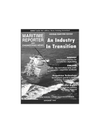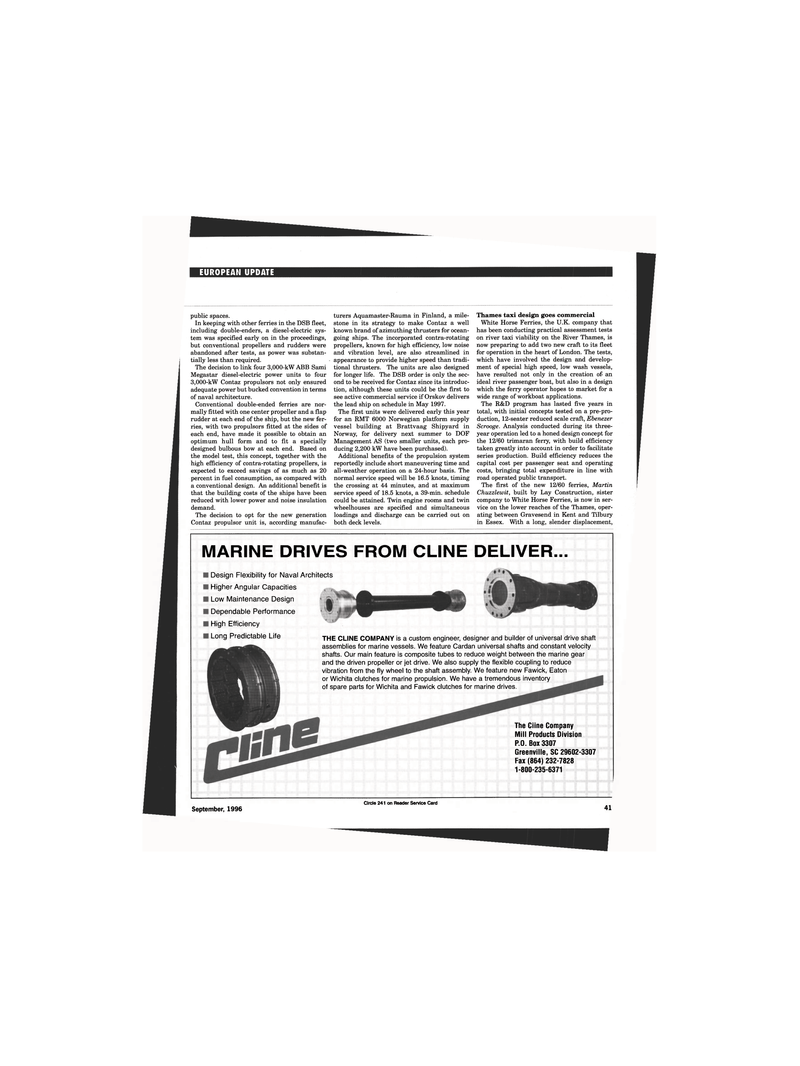
Page 41: of Maritime Reporter Magazine (September 1996)
Read this page in Pdf, Flash or Html5 edition of September 1996 Maritime Reporter Magazine
EUROPEAN UPDATE public spaces.
In keeping with other ferries in the DSB fleet, including double-enders, a diesel-electric sys- tem was specified early on in the proceedings, but conventional propellers and rudders were abandoned after tests, as power was substan- tially less than required.
The decision to link four 3,000-kW ABB Sami
Megastar diesel-electric power units to four 3,000-kW Contaz propulsors not only ensured adequate power but bucked convention in terms of naval architecture.
Conventional double-ended ferries are nor- mally fitted with one center propeller and a flap rudder at each end of the ship, but the new fer- ries, with two propulsors fitted at the sides of each end, have made it possible to obtain an optimum hull form and to fit a specially designed bulbous bow at each end. Based on the model test, this concept, together with the high efficiency of contra-rotating propellers, is expected to exceed savings of as much as 20 percent in fuel consumption, as compared with a conventional design. An additional benefit is that the building costs of the ships have been reduced with lower power and noise insulation demand.
The decision to opt for the new generation
Contaz propulsor unit is, according manufac- turers Aquamaster-Rauma in Finland, a mile- stone in its strategy to make Contaz a well known brand of azimuthing thrusters for ocean- going ships. The incorporated contra-rotating propellers, known for high efficiency, low noise and vibration level, are also streamlined in appearance to provide higher speed than tradi- tional thrusters. The units are also designed for longer life. The DSB order is only the sec- ond to be received for Contaz since its introduc- tion, although these units could be the first to see active commercial service if Orskov delivers the lead ship on schedule in May 1997.
The first units were delivered early this year for an RMT 6000 Norwegian platform supply vessel building at Brattvaag Shipyard in
Norway, for delivery next summer to DOF
Management AS (two smaller units, each pro- ducing 2,200 kW have been purchased).
Additional benefits of the propulsion system reportedly include short maneuvering time and all-weather operation on a 24-hour basis. The normal service speed will be 16.5 knots, timing the crossing at 44 minutes, and at maximum service speed of 18.5 knots, a 39-min. schedule could be attained. Twin engine rooms and twin wheelhouses are specified and simultaneous loadings and discharge can be carried out on both deck levels.
Thames taxi design goes commercial
White Horse Ferries, the U.K. company that has been conducting practical assessment tests on river taxi viability on the River Thames, is now preparing to add two new craft to its fleet for operation in the heart of London. The tests, which have involved the design and develop- ment of special high speed, low wash vessels, have resulted not only in the creation of an ideal river passenger boat, but also in a design which the ferry operator hopes to market for a wide range of workboat applications.
The R&D program has lasted five years in total, with initial concepts tested on a pre-pro- duction, 12-seater reduced scale craft, Ebenezer
Scrooge. Analysis conducted during its three- year operation led to a honed design concept for the 12/60 trimaran ferry, with build efficiency taken greatly into account in order to facilitate series production. Build efficiency reduces the capital cost per passenger seat and operating costs, bringing total expenditure in line with road operated public transport.
The first of the new 12/60 ferries, Martin
Chuzzlewit, built by Lay Construction, sister company to White Horse Ferries, is now in ser- vice on the lower reaches of the Thames, oper- ating between Gravesend in Kent and Tilbury in Essex. With a long, slender displacement,
MARINE DRIVES FROM CLINE DELIVER...
Design Flexibility for Naval Architects
Higher Angular Capacities
Low Maintenance Design
Dependable Performance
High Efficiency
Long Predictable Life THE CLINE COMPANY is a custom engineer, designer and builder of universal drive shaft assemblies for marine vessels. We feature Cardan universal shafts and constant velocity shafts. Our main feature is composite tubes to reduce weight between the marine gear and the driven propeller or jet drive. We also supply the flexible coupling to reduce vibration from the fly wheel to the shaft assembly. We feature new Fawick, Eaton or Wichita clutches for marine propulsion. We have a tremendous inventory of spare parts for Wichita and Fawick clutches for marine drives.
The Ciine Company
Mill Products Division
P.O. Box 3307
Greenville, SC 29602-3307
Fax (864) 232-7828 1-800-235-6371
September, 1996
Circle 241 on Reader Service Card 41

 40
40

 42
42
